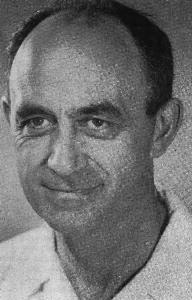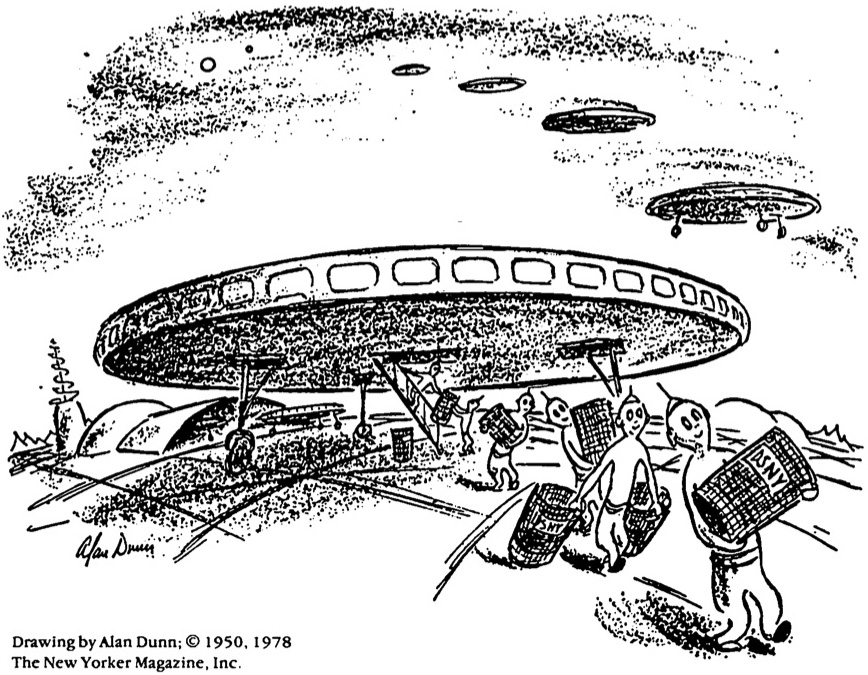La fameuse question de Fermi , aujourd'hui centrale
dans les débats sur la prévalence des civilisations extraterrestres, fut soulevée lors d'une conversation de dejeuner
avec Emil Konopinski, Edward Teller
, aujourd'hui centrale
dans les débats sur la prévalence des civilisations extraterrestres, fut soulevée lors d'une conversation de dejeuner
avec Emil Konopinski, Edward Teller et Herbert York à l'été . Les compagnons de Fermi
et Herbert York à l'été . Les compagnons de Fermi ce
jour-là ont fourni des récits de l'incident.
ce
jour-là ont fourni des récits de l'incident.
Une partie du débat actuel sur l'existence et la prévalence des extraterrestres concerne le voyage et la colonisation interstellaire [1-3]. En , Michael Hart argua que le voyage interstellaire serait réalisable pour une civilisation technologiquement avancée et qu'une migration remplirait la Galaxie en quelques millions d'années [4]. Cet intervalle étant court en comparaison de l'âge la Galaxie, il conclut alors que l'absence de colons ou d'indice de leurs projets d'ingéniérie dans le Système Solaire signifie qu'il n'y a pas d'extraterrestres.
Newman, Sagan et Shklovski [2,5]
se souviennent qu'une légende de la science raconte que Enrico
Fermi posa la question,
posa la question, Où sont-ils ?
lors d'une visite à Los
Alamos durant la 2de guerre mondiale ou peu après. La question de Fermi a été
mentionnées dans plusieurs autres publications récentes, mais le fondement historique pour l'attribution n'a pas été
établi. Grâce à la très bonne mémoire d'Hans Mark, qui avait entendu le récit raconté à
Los Alamos au début des années 1950s, nous savons maintenant que Fermi ne fit pas la remarque lors d'une conversation
de déjeuner vers . Ses compagnons étaient Emil Konopinski, Edward Teller
a été
mentionnées dans plusieurs autres publications récentes, mais le fondement historique pour l'attribution n'a pas été
établi. Grâce à la très bonne mémoire d'Hans Mark, qui avait entendu le récit raconté à
Los Alamos au début des années 1950s, nous savons maintenant que Fermi ne fit pas la remarque lors d'une conversation
de déjeuner vers . Ses compagnons étaient Emil Konopinski, Edward Teller et Herbert York. Tous les trois ont fourni des
récits de l'incident.
et Herbert York. Tous les trois ont fourni des
récits de l'incident.

Commençons avec Konopinski:
Je n'ai que des souvenirs fragmentaires de cette occasion... J'ai un souvenir assez clair de comment la discussion sur les extra-terrestres a commencé alors que Enrico, Edward, Herb York et moi-même marchions pour aller dejeuner à Fuller Lodge.
Lorsque je les ai rejoints, je les trouvais en trains de discuter des soucoupes volantes. Ca a m'immédiatement rappelé un dessin que j'avais vu récemment dans le New Yorker, qui expliquait pourquoi les poubelles publiques disapparaissaient des rues de New York. Les journaux de New York en faisaient tout un foin. Le dessin montrait ce qui était une soucoupe évidente posées en fond et, allant vers elle, des "petits hommes verts" (avec des antennes) emportant les poubelles. More amusing was Fermi's comment, that it was a very reasonable theory since it accounted for two separate phenomena: the reports of flying saucers as well as the disappearance of the trash cans. There ensued a discussion as to whether the saucers could somehow exceed the speed of light."
Teller remembers:
My recollection of the event involving Fermi . . . is clear, but only partial. To begin with, I was there at the incident. I believe it occurred shortly after the end of the war on a visit of Fermi to the Laboratory, which quite possibly might have been during a summer.
I remember having walked over with Fermi and others to the Fuller Lodge for lunch. While we walked over, there was a conversation which I believe to have been quite brief and superficial on a subject only vaguely connected with space travel. I have a vague recollection, which may not be accurate, that we talked about flying saucers and the obvious statement that the flying saucers are not real. I also remember that Fermi explicitly raised the question, and I think he directed it at me, 'Edward, what do you think? How probable is it that within the next ten years we shall have clear evidence of a material object moving faster than light?' I remember that my answer vas ' 1 o-6.. Fermi said, 'This is much too low. The probability is more like ten percent' (the well known figure for a Fermi miracle.)
Konopinski says that he does not recall the numerical values, except that they changed rapidly as Edward and Fermi
bounced arguments off each other.
Teller continues:
"The conversation, according to my memory, was only vaguely connected with astronautics partly on account of flying saucers might be due to extraterrestrial people (here I believe the remarks were purely negative), partly because exceeding light velocity would make interstellar travel one degree more real.
"We then talked about other things which I do not remember and maybe approximately eight of us sat down together for lunch." Konopinski and York are quite certain that there were only four of them.
It was after we were at the luncheon table," Konopinski recalls, "that Fermi surprised us with the question 'but where is everybody?' It was his way of putting it that drew laughs from us ."
York, who does not recall the preliminary conversation on the walk to Fuller Lodge, does remember that "virtually apropos of nothing Fermi said, 'Don't you ever wonder where everybody is?' Somehow . . . we all knew he meant extra-terrestrials."
Teller remembers the question in much the same way. "The discussion had nothing to do with astronomy or with extraterrestrial beings. I think it was some down-to-earth topic. Then, in the middle of this conversation, Fermi came out with the quite unexpected question 'Where is everybody?' . . . The result of his question was general laughter because of the strange fact that in spite of Fermi's question coming from the clear blue, everybody around the table seemed to understand at once that he was talking about extraterrestrial life.
"I do not believe that much came of this conversation, except perhaps a statement that the distances to the next location of living beings may be very great and that, indeed, as far as our galaxy is concerned, we are living somewhere in the sticks, far removed from the metropolitan area of the galactic center."
York believes that Fermi was somewhat more expansive and "followed up with a series of calculations on the probability of earthlike planets, the probability of life given an earth, the probability of humans given life, the likely rise and duration of high technology, and so on. He concluded on the basis of such calculations that we ought to have been visited long ago and many times over. As I recall, he went on to conclude that the reason we hadn't been visited might be that interstellar flight is impossible, or, if it is possible, always judged to be not worth the effort, or technological civilization doesn't last long enough for it to happen." York confessed to being hazy about these last remarks.
In summary, Fermi did ask the question, and perhaps not surprisingly, issues still debated today were part of the discussion . Certainly, the line of argument that York remembers became familiar a decade later as the Drake-Greenbank Equation [6,7].
A final point: the date of the conversation. York is clearest on the date. "The conversation was either in the summer of 1950, 1951, or 1952, very probably 1951, and took place . . . when I was visiting LASL in connection with the forthcoming Greenhouse tests - specifically, the George shot." The George test occurred on May 8, 1951, suggesting a 1950 date. Surviving correspondence from the time indicates that Fermi was an annual summer visitor during the years in question. Unfortunately, attendance and travel records for those years have been destroyed. However, we have the evidence of the cartoon Konopinski mentions. Drawn by Alan Dunn, it was published in the May 20, 1950, issue of The New Yorker. It seems quite probable that the incident of Fermi's question occurred in the summer of 1950.
I am grateful to Hans Mark and to the three surviving participants for their accounts. These accounts, together with my letters of inquiry, are reproduced in the following pages.